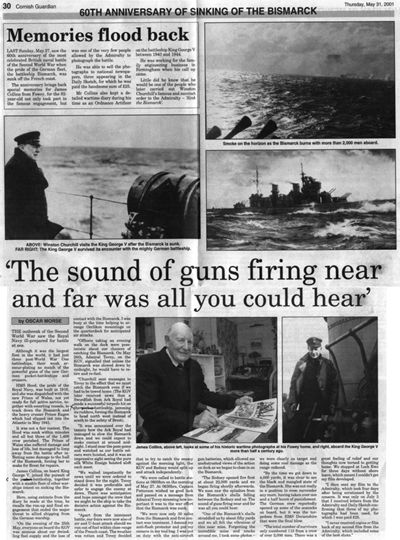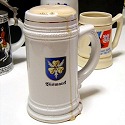
Cornish Guardian, May 31, 2001 (regional newspaper)
(Courtesy of Oliver Tattersall, grandson of British veteran James Collins)
 Page 30 of the Cornish Guardian of May 31, 2001.
Page 30 of the Cornish Guardian of May 31, 2001.
60TH ANNIVERSARY OF SINKING OF THE BISMARCK
Memories flood back
LAST Sunday, May 27, saw the 60th anniversary of the most celebrated British naval battle of the Second World War when the pride of the German fleet, the battleship Bismarck, was sunk off the French coast.
The anniversary brings back special memories for James Collins from Fowey, for the 82-year-old not only took part in the famous engagement, but was one of the very few people allowed by the Admiralty to photograph the battle.
He was able to sell the photographs to national newspapers, three appearing in the Daily Sketch, for which he was paid the handsome sum of £25.
Mr Collins also kept a detailed wartime diary during his time as an Ordnance Artificer on the battleship King George V between 1940 and 1944.
He was working for the family engineering business in Birmingham when his call up came.
Little did he know that he would be one of the people who later carried out Winston Churchill's famous and succinct order to the Admiralty - "Sink the Bismarck".
"The sound of guns firing near
and far was all you could hear"
By OSCAR MORSE
THE outbreak of the Second World War saw the Royal Navy ill-prepared for battle at sea.
Although it was the largest fleet in the world, it had just three post-World War One battleships, their weak armour-plating no match of the powerful guns of the new German pocket-battleships and cruisers.
HMS Hood, the pride of the Royal Navy, was built in 1916, and she was dispatched with the new Prince of Wales, not yet ready for full active service, together with escorting vessels, to track down the Bismarck and the heavy cruiser Prinz Eugen which had slipped out into the Atlantic in May 1941.
It was not a fair contest. The Hood was sunk within minutes and all but three of the 1,400 crew perished.
The Prince of Wales also suffered damage and loss of life, but managed to limp away from the battle after inflicting some damage to the hull of the Bismarck, forcing her to make for Brest for repairs.
James Collins, on board King George V, joined the pursuit of the battleship, together with a sizable fleet of other warships intent on sinking the Bismarck.
Here, using extracts from the diary he made at the time, he recalls the run-up and final engagement that ended the major threat to allied shipping from the German warship.
"On the evening of the 25th May, everyone on board the KGV was anxious about our dwindling fuel supply and the loss of contact with the Bismarck.
I was busy at the time helping to arrange Oerlikon mountings on the quarterdeck for anticipated air attacks.
Officers taking an evening walk on the deck were pessimistic about our chances of catching the Bismarck.
On May 26th, Admiral Tovey, on the KGV, signalled that unless the Bismarck was slowed down by midnight, he would have to retire and re-fuel.
Churchill sent messages to Tovey to the effect that we must catch the Bismarck even if we had to be towed home. (The KGV later received news that a Swordfish from Ark Royal had made a successful torpedo hit on the battleship, jamming its rudders, forcing the Bismarck to head north west instead of south to the safety of Brest).
It was announced over the tannoy how the Ark Royal had managed to slow the Bismarck down and we could expect to make contact at around midnight.
I stood near the pom-poms and watched as our battle colours were hoisted, and it was an impressive sight seeing the pure silk White Ensign hoisted aloft each mast.
We waited impatiently for news until we were ordered to stand down for the night.
Tovey decided it was preferable and safer to engage the enemy at dawn.
there was anticipation and hope amongst the crew that we might be the ship to take the decisive action against the Bismarck.
Apart from the imminent battle, our fears were now also of air and U-boat attack should we run out of fuel within close range of the French coast.
The weather was rotten and Tovey decided to try to catch the enemy against the morning light, the KGV and the Rodney would split up and attack independently.
We were called to battle stations at 0600hrs on the morning of May 27.
At 0630hrs, Captain Patterson wished us good luck and passed on a message from Admiral Tovey stressing how important it was to the war effort that the Bismarck was sunk.
We were now only 30 miles from the Bismarck and first contact was imminent.
I donned my anti-flash protector and put my camera in my tool bag.
I was put on duty with the anti-aircraft gun batteries, which allowed me unobstructed views of the action on deck as we began to close in on the Bismarck.
The Rodney opened fire first at about 22,000 yards and we began firing shortly afterwards.
We soon saw the splashes from the Bismarck's shells falling between the Rodney and us.
The sound of guns firing near and far was all you could hear.
One of the Bismarck's shells straddled us by about fifty yards and we all felt the vibration of the near miss.
Forgetting the incredible noise and smoke around me, I took some photos - we were clearly on target and doing some real damage as the range reduced.
By the time we got down to 4,000 yards, it was clear to see the black and mangled state of the Bismarck.
She was not really in a position to even surrender any more, having taken over one and a half hours fo punishment.
The German crew reportedly opened up some of the seacocks on board, but it was the torpedoes from the HMS Dorsetshire that were the final blow.
The total number of survivors only numbered 115 from a crew of over 2,000 men.
There was a great feeling of relief and our thoughts now turned to getting home.
We stopped at Loch Ewe for three days without shore leave, which meant I couldn't get my film developed.
I then sent my film to the Admiralty, which took four days after being scrutinised by the censors.
It was only on July 3 that I received letters from the Admiralty and Daily Sketch confirming that three of my photographs had been used, for which I was paid £25.
I never received copies or film back of my second film from the Admiralty, which included some of the best shots."
 eBook: Battleship Bismarck.
The Complete History of a Legendary Ship.
 Naval, military gifts
and souvenirs.
|
|




